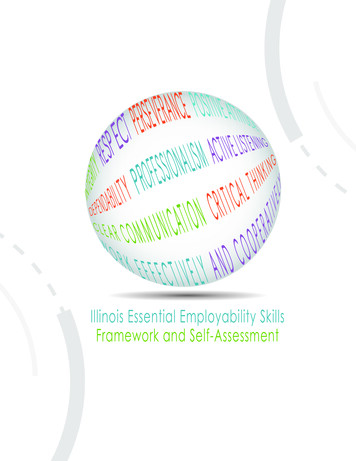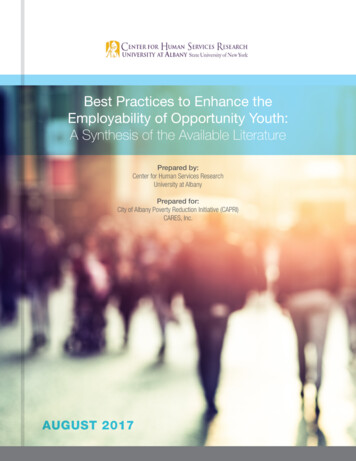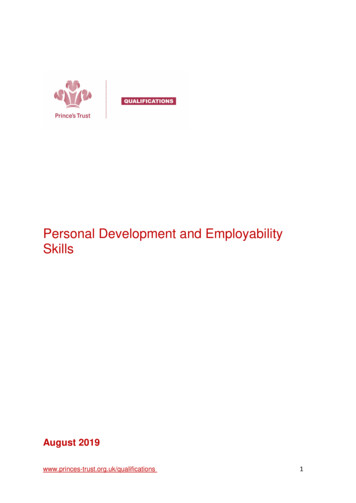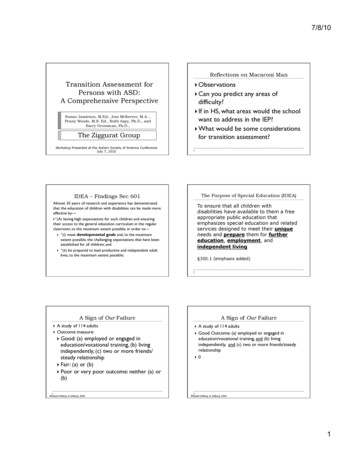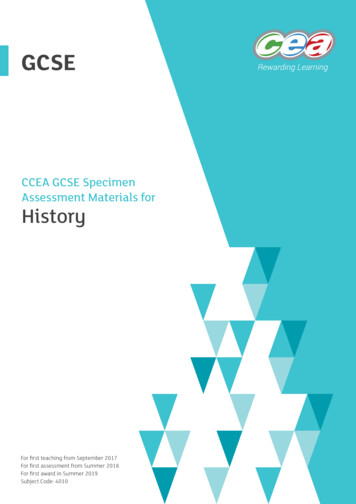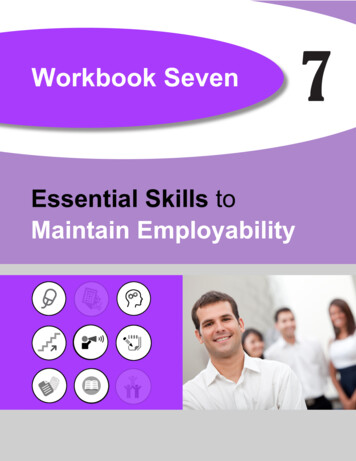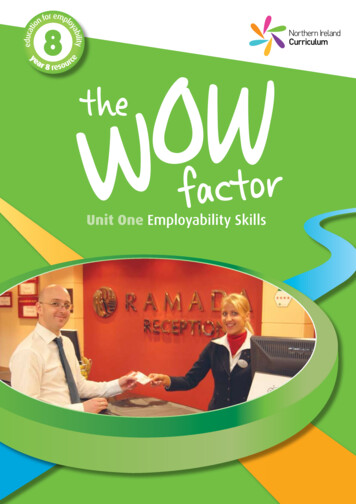
Transcription
Unit One Employability Skills
1ContentsUnit Overview3Learning and Teaching Activities within this Unit5Theme 1What Are Employability Skills,Qualities and Values?6Theme 2Communicate It8Theme 3Team Effort10Theme 4Solve It12Theme 5Employability and Me13ResourcesUseful Websites
2AimIn this unit, pupils explore employability skills,qualities and values. In particular, they find outhow employability skills, qualities and valuestranslate into the workplace. They also practiceand develop employability skills.
3Unit OverviewMapped to theStatutory StatementsEmployability Skills FocusPupils should have opportunities to:This unit allows pupils todevelop the skills that meetthe statutory requirementsof the revised curriculum atKey Stage 3. The focus withinthis unit is outlined below:- practise presentational and self-marketingskills; and- assess their personal skills and achievementsto date.Learning IntentionsPupils learn that:- employability skills, qualities and values areimportant in the workplace; and- it is important to be able to describedifferent employability skills, qualitiesand attitudes.Working with Others- Show that they can work in different roles in a groupand take responsibility for appropriate tasks.Success CriteriaAt the end of this unit, pupils will:- be able to identify some employabilityskills, qualities and values;- know how to describe some employabilityskills, qualities and values;- recognise the importance of employabilityskills, qualities and values in the workplace;and- know how they can practice and developemployability skills, qualities and values.yOpportusnsmitentfor Asseearning!for L learninggSharin ons andtineinteriass criteccsuKey QuestionsThroughout this unit, encourage pupils toconsider the following questions:- What are employability skills, qualities and values?- Why are they important in the workplace?- What are the benefits of practisingemployability skills?yOpportusnsmitentfor Asseearning!for L earningglSharin ons andtininteeriass critecsuc
4
5Learning and TeachingActivities within this UnitTheme 1Theme 4What Are Employability Skills,Qualities and Values?Solve ItPupils explore the most common employability skills,qualities and values. They examine what these skills,qualities and values mean and why they are important.Theme 2Communicate ItPupils investigate communication skills and theirimportance in the workplace. They have opportunitiesto practise communication skills.Theme 3Team EffortPupils explore teamwork and the importance ofteamwork in the workplace. They have opportunitiesto practise teamwork skills.Pupils explore problem-solving and decision-makingskills and their importance in the workplace. Theyhave opportunities to practise problem-solving anddecision-making skills.Theme 5Employability and MePupils reflect on their own employability skills,qualities and values.
6Theme 1What Are EmployabilitySkills, Qualities and Values?Pupils explore the mostcommon employabilityskills, qualities andvalues. They examinewhat these skills, qualitiesand values mean and whythey are important.Opportunity forrningAssessment for Leantsmpt statemeProviding pronsioupils’ questGenerating pActivity 1Give a sticky label to each pupil in the class. Ask them towrite down a word that would describe someone whois good at their job. It might be necessary to focus thepupils’ thinking. If so, ask them to think about a familiarrole, for example a teacher, nurse, fire fighter or builder.When the pupils’ have finished, collect all of the stickylabels and display them in the classroom. As a class,read and discuss the words that are written on them.Explain to the pupils that these words are examples ofemployability skills, qualities and values.Organise the class into groups of four or five pupils.Provide each group with a set of the EmployabilitySkills, Qualities and Values Cards. Invite them to classifythe cards into three categories; employability skills,employability qualities and employability values. It maybe necessary to provide some prompts to help themclassify the cards, for example:- I can. (skills);- I am. (qualities); and- I believe in. (values).When the groups have finished, invite them to chooseat least four of the Employability Skills, Qualities andValues Cards. Ask them to write a short definition of thewords that appear on the cards. Next, invite a reporterfrom each group to read their definitions to the rest ofthe class. Invite other groups to guess the skill, qualityor value being described.Support Materials for the Activities- Employability Skills, Qualities andValues Cards (Resource 1)- Employability Skills, Qualities and ValuesCards Teacher Briefing Sheet (Resource 2)- Sticky Labels- Flip chart paperFinally, use Employability Skills, Qualities and ValuesCards Teacher Briefing Sheet to describe each of theemployability skills, qualities and values to the pupils.
7Activity 2Ask the pupils to get back into the same groups asin Activity 1. Provide each group with a sheet of flipchart paper with a familiar job role written on thecentre, for example:- plumber;- shop assistant;- fire fighter;- nurse;- chef;- hairdresser; and/or- vet.Invite groups to agree on three skills, two values andthree qualities that are important for their allocatedjob. Ask them to record the skills, values and qualitieson their flip chart page. When they have finished,invite a reporter from each group to present andjustify their choices to the rest of the class.Activity 3Invite the pupils to work in pairs or groups of three.Ask them to choose a job that they are familiar with.Next, ask them to generate up to five statements toillustrate why a person performing that role wouldrequire some of the employability skills, qualities andvalues in their everyday work. Invite the pupils toread their statements aloud and encourage the rest ofthe class to guess the job.Invite the pupils to think of three questions that couldbe used to interview someone who was applying forthe role. Provide time for the pupils to carry out roleplay scenarios of the interview.Extension Opportunity – Activity 4Organise the pupils into pairs. Give each pair one ofthe Employability Skills, Qualities and Values Cards.Invite them to draw an image to illustrate theirallocated card. When they have drawn their image,ask each pair to team up with another pair of pupils.Invite them to take turns to look at the images and tryto guess the skill, quality or value.As a de-brief to this activity, use the followingquestions to prompt a class discussion:- Were there any similarities or differences in howthe same employability skills, qualities and valueswere illustrated by different pairs of pupils?- In what ways was it hard to draw an image ofan employability skill, quality or value?- How can a visual image of a skill make it easierto understand?
8Theme 2Communicate ItPupils investigatecommunication skills andtheir importance in theworkplace. They haveopportunities to practisecommunication skills.ity ntnutroOppAssessme g!foror Learnin iteriafcrcesscg su wn andnitagoerngGen ssessin ork usi riaeArs’ w ess critehtcouced sergaSupport Materials for the Activities- Employability Skills – Odd One Out(Resource 3)- Communication Skills Task (Resource 4)- Communication Chain (Resource 5)Activity 1Display the Employability Skills – Odd One Out resourcein the classroom. Ask the pupils to work individuallyand consider which action is the ‘odd one out’. Next,invite them to share their thoughts with the personnext to them. Finally, invite the pupils to share theiropinions with the rest of the class. Ask them to justifytheir answers.Hint:There is no right or wrong answer. The employabilityskills listed on the resource are all examples ofcommunication. However the pupils might interpretthese differently, for example they might consider‘dealing with a customer complaint’ as problemsolving or ‘designing a logo’ as using ICT.As a class, re-cap on ways in which peoplecommunicate. Make a list of the pupils’ responses onthe board or on a flip chart. Responses might include:- talking face to face;- writing a letter;- sending an email;- talking on the telephone; and/or- writing a note.Discuss with the class ways they are developing theircommunication skills at school. Organise the pupilsinto small groups of four individuals. Challenge themto create a collage that illustrates the ways theydevelop their communication skills at school. Agreethe success criteria in advance, for example:- uses words and images;- illustrates at least five examples; and/or- includes written and verbal examples.
9When groups have completed this task, ask them toconsider how well they worked as a team and whatthey would do differently next time.Provide time for a reporter from each group to presenttheir collage to the rest of the class. Discuss how theseexamples might help when applying for a job in thefuture.Activity 2Invite the pupils to suggest why communication skills areimportant in the workplace. Responses might include:- to ensure that staff know their rolesand responsibilities;- so that customers are able to find out aboutproducts/services;- to ensure that a task/work is carried out properly;and/or- so that good working relationships are builtand maintained.Display a copy of the Communications Skills Task inthe classroom. This task illustrates the importanceof clear communication. Ask for volunteers for thefollowing roles:- director;- informer; and- builder.Explain to the rest of the class that their role is that ofobservers. Explain the aim of the task and the rulesto the pupils. Provide time for the pupils to carry outthe task. Afterwards encourage them to reflect onhow successful their communication skills were whencarrying out the task. Invite them to agree on:- one thing they did well;- one thing that didn’t work so well; and- one thing they would do better next time.Activity 3Organise the class into groups of five pupils. Ask eachgroup to line up in a straight line but stand about anarms length from each other. Give the pupils at thestart of each line a copy of the Communication Chainresource. Ask them to make sure that the rest of theirgroup cannot see what is drawn on it. Give a blankpiece of paper and a pencil to each of the pupils at theend of the lines.Explain the following rules to the pupils:- The pupil at the start of the line must try to describethe image on the Communication Chain to thesecond person in the line.- The second person in the line must pass on thisinformation to the third person in the line.- The pupils must continue to communicate thisinformation down their line.- The pupil at the end of the line must use theinformation provided by the pupil next to them todraw the image featured on the Communication Chain.- Pupils must only communicate with the person nextin line to them.- They can communicate up and down the line asmany times as required in the given timeframe(for example 5 minutes).- Make sure that groups don’t start until you tellthem to.When groups have completed this task, invite themto compare the images on the Communication Chainand the images drawn by the last person in the line.Encourage them to consider how they could haveimproved their communication to ensure the imageswere more accurate.Provide time for the class to discuss the importanceof good communication skills and the effects of badcommunication skills. Invite the pupils to think aboutthe importance of communication skills in a range offamiliar roles, for example:- sales assistant;- fire fighter;- nurse; and/or- hotel receptionist.Activity 4 Extension OpportunityInvite the pupils to choose a job and create a job advertthat illustrates the employability skills, qualities andvalues that would be required in the job.
10Theme 3Team EffortPupils explore teamworkand the importanceof teamwork in theworkplace. They haveopportunities to practiseteamwork skills.Opportunifor Assess tymentforLearning!Generating succeAssessingss criteriowork b wn and oth aeased on agre rs’succeseds criteEffective que riastioningSupport Materials for the Activities- Team Role Cards (Resource 6)- Number Cards (Resource 7)- Team Quotation Cards (Resource 8)- Glossy magazines and newspapers- Scissors- Glue- Flip chart paper- Markers- Coloured pencils/pens- Sticky labelsActivity 1Invite the pupils to describe the characteristics ofsuccessful teamwork, for example:- no fighting;-everyone listens to speaker;all contributions are valued;everyone gets a chance to contribute; andeye contact is maintained with each other.Record their answers on the board or flip chart.Next, divide the class into groups of six pupils. Giveeach group a set of the Team Role Cards. Invitethem to allocate group roles. Distribute some glossymagazines and newspapers to each group. Invitethem to use these to create a poster that illustratesteamwork. Provide product success criteria for thistask, for example:- uses words and phrases taken from the magazinesand newspapers;- is colourful;- has a title; and- is eye-catching.During the activity, walk around the room and observethe groups. Take note of instances where teamwork(based on the agreed characteristics) is evident.When groups have finished the task, invite thereporters to present their poster to the rest of theclass. Encourage them to suggest how they achievedthe product success criteria.As a de-brief to this activity, share your observationsof the teamwork within the groups.Activity 2Organise pupils into groups of ten individuals.Distribute a set of the Number Cards to each group.Ask them to place the nine numbered cards on thefloor, in a 3 x 3 grid. Distribute nine sticky labels toeach group. Ask them to write a different number oneach label, in the range of 1 to 9.Ask the groups to nominate two group members toact as observers. Next, invite the remaining eightmembers of the group to choose one of the stickylabels and to fix this to their jumper. Ask these pupilsto stand on one of the numbers in the grid, howeverinform them that they must not stand on the samenumber as on their sticky label.
11If the pupils follow the instructions correctly, thereshould be one unoccupied square on the grid and twopupils not standing on the grid.Challenge the groups to work together to move eachpupil to the number on the grid that correspondsto the number on their sticky label, in the shortestamount of time.Rules:Pupils can only move vertically or horizontally, andcannot step off the grid.The role of the observers is to watch how the teamco-operates and communicates with each other.Give the pupils a set time to complete this task. Whenthey have finished, invite the observers to describehow well their group co-operated and communicatedwith each other. Encourage other group membersto discuss the features of teamwork that helped orhindered their progress.Explain to the pupils that the aim of this activity isto try to untangle the human knot within a giventimeframe. Inform the groups that it is acceptablefor some team members to end up facing outwardsinstead of inwards.During de-brief, discuss some of the strategies usedby the groups for example,- going under each other’s arms;- kneeling down to allow another group member tostep over your arm;- moving slowly; and/or- moving one person at a time.Remind the pupils of the requirements of successfulteamwork.Invite the pupils to repeat this activity to see if theycan untangle the human knot faster and improve theirteamwork skills.Extension Opportunity - Activity 4As a class, discuss how working as a team requires:- good communication, both verbal and non verbal;- people to adopt a range of roles, for exampleleader, organiser, observer and/or direction taker;- listening actively and sharing opinions;- taking turns, sharing and co-operating;- understanding how actions and words affect others;- giving and responding to feedback;- being fair;- respecting the views and opinions of others andreaching agreements; and- using negotiation and compromise.Organise the class into five groups. Cut each of theTeam Quotation Cards into individual words andshuffle them. Distribute one set of jumbled words toeach group. Invite the groups to rearrange the wordsto make a sentence or statement that describes ateam or teamwork. When the groups have finished,invite them to read their sentence or statement aloud.Encourage all group members to read part of thesentence or statement. This will help the group checkfor accuracy and give each pupil a chance to speak infront of their group.Extension Opportunity - Activity 3Invite the pupils to talk about the dynamics of theirgroup, in particular which pupils demonstratedleadership skills and how well the groupcommunicated with each other.Organise the class into groups of six to ten individuals.Ask the members of each group to stand shoulderto-shoulder in a circle and to face inwards. Next, askthe pupils to reach across the circle with one handand to grab the hand of another group member (thiscan be any other member except the person they arestanding beside).As a de-brief to this activity, encourage the pupils toanswer the following questions:- In what ways did you need to work as a team?- What is difficult about teamwork?- What is good about teamwork?
12Theme 4Solve ItPupils exploreproblem-solving anddecision-making skillsand their importance inthe workplace. They haveopportunities to practiseproblem-solving anddecision-making skills.yOpportusnsmitentfor Asseearning!for LiveEffect siontquesSupport Materials for the Activities- Consider All Factors Template (Resource 9)- Work-Related Problem Cards (Resource 10)Activity 1Choose a school-related problem, for example litter orbullying. Display the Consider All Factors Template onthe board or on a flip chart. Use this to illustrate to thepupils how effective decision-making can be useful infinding a solution to problems.Divide the class into groups of four or five pupils.Give each group one of the Work-Related ProblemCards. Ask each group to use the Consider All FactorsTemplate to help them work through their problem.Ask a reporter from each group to provide feedbackon their problem-solving activity.As a de-brief to this activity, encourage the pupils toanswer the following questions:- How did the Consider All Factors Template helpyou solve the problem?- Which was the most difficult step in theproblem-solving process?Extension Opportunity Activity 2Invite employers or employees from the localcommunity to come into the school and talk about thefollowing:- What kind of work-related problems they havehad in the past?- What factors did they have to consider?- What steps did they take to resolve problems?- Who decides how a problem is resolved?
13Theme 5Employability and MePupils reflect on theirown employability skills,qualities and values.tyOpporsteusnsmi entfor AsLearning!forveiEffect nsoiquestActivity 1Allow the pupils to take digital photographs ofeach other. Then, ask them to think about whichemployability skills, qualities and values could be usedto describe themselves. Ask the pupils to record theseskills, values and qualities. Next, invite the pupils touse their photograph and the list of skills, qualities andvalues to make a personal employability skills card.If possible, allow the pupils to use ICT software suchas Microsoft Publisher. If your school has a laminator,allow the pupils to laminate their skills card fordurability. Ask the pupils to keep their employabilityskills card, as they can build upon them in the nextunit when they learn about enterprising skills.Extension Opportunity Activity 2Support Materials for the Activities- Pupil Reflection Record (Resource 11)- Digital camera- Card- Laminator- Scissors or guillotineDistribute a copy of the Pupil Reflection Record toeach pupil. Encourage them to read this and thinkabout their learning to date. Ask the pupils tocomplete the Pupil Reflection Record. Finally, invitethem to take part in a group discussion to share theirlearning with each other.It might be useful to record feedback from individualpupils in their Progress File.
Education for Employability - Year 8 ResourceThe WOW Factor - Unit 1: Employability SkillsResource 1Employability Skills, Qualitiesand Values Cards (1 of 2)CommunicateWork in a teamSolve problemsand makedecisionsBe enterprisingPlan and organiseUse ICTUse mathematicsTake the leadDependableReliableHardworkingIndependent
Resource 1Education for Employability - Year 8 ResourceThe WOW Factor - Unit 1: Employability SkillsEmployability Skills, Qualitiesand Values Cards (2 of tyQualityPositive elong learning
Education for Employability - Year 8 ResourceThe WOW Factor - Unit 1: Employability SkillsResource 2Employability Skills, Qualities and ValuesCards Teacher Briefing Sheet (1 of 2)Skills DefinedCommunicationThis is the ability to clearly get your message across to a variety of people so that everyone can understand it.Communication can take place in a variety of ways, for example:- face to face (through meetings or presentations);- written (using letters, e-mails or posters); and/or- by talking on the telephone.Communication is also the ability to decide which of the above methods is the best way to get the messageacross to people.TeamworkTeamwork is when a group of individuals work together with a common goal. Each person within theteam has a role to carry out to ensure the task is completed successfully.Problem-solving and decision-makingThis is the ability to:- spot problems on time; and- use the information available to make the right decision to solve the problem.Being enterprisingThis is the ability to use your imagination to come up with new ideas to improve the workplace. Enterprisingpeople show a willingness and readiness to undertake new challenges even when the outcome is unknown.Planning and organisingThis is the ability to accurately decide the who, what, how and when of achieving a goal or completing a task.Using ICTThis is the ability to use technology as a tool to help manage information, for example:- researching on the internet;- storing information on a database; and/or- processing letters or communicating with the use of e-mail, PowerPoint or another computer package.Using MathematicsThis is the ability to use mathematics to carry out a variety of tasks effectively, for example:- calculating percentages;- measuring and drawing plans; and/or- analysing graphs and trends to make predictions.Leadership skillsThis is the ability to:- inspire a team of people around you to get them to want to work to their best ability; and- create a vision that is shared by all so that everyone knows the future goals and how they aregoing to achieve them.
Education for Employability - Year 8 ResourceThe WOW Factor - Unit 1: Employability SkillsResource 2Employability Skills, Qualities and ValuesCards Teacher Briefing Sheet (2 of 2)Qualities DefinedDependableBeing able to make sure people know you will do the job and do it well.ReliableBeing able to show that people can trust in you and in your work.HardworkingTaking great care and perseverance to get a task done.IndependentNot needing to rely on other people to get a job done.ProactiveMaking things happen instead of waiting to be told what to do (sometimes referred to as showing initiative).Co-operativeWorking well with others to get jobs done.EnthusiasticShowing real and genuine interest in a job.PunctualAlways being on time or having things ready on time.Values DefinedIntegrityActing in a way that is open and honest. Not being influenced by others to act inappropriately.QualityHigh level of excellence.Positive relationshipsMaking good connections with others.ResponsibilityBeing able to say what, how and why you have worked in a certain way.HonestyActing truthfully at all times.FairnessSticking to the rules without having a negative effect on others.TrustHaving confidence in someone or something.Lifelong learningContinually developing skills and knowledge to improve self and ways of working.
Education for Employability - Year 8 ResourceThe WOW Factor - Unit 1: Employability SkillsResource 3Employability Skills Odd One OutSending an emailHolding a meetingUsing the telephoneDealing with acustomer’s complaintTyping a letterDesigning a new logo
Education for Employability - Year 8 ResourceThe WOW Factor - Unit 1: Employability SkillsResource 4Communication Skills TaskAim: to demonstrate the importance of clear communication.Materials: two sets of 10 building blocks.Time: 15 minutes.Roles- Builder- Director- Informer- ObserversInstructionsThe teacher should build a random object using one set of blocks.Ensure that the object is hidden from the rest of the class.The Rules- The director is the only person who can see the object.- It is the director’s job to give clear instructions to the informer, so that the buildercan build an exact replica of the model.- The informer listens to the director’s instructions and goes to a different part ofthe room to where the builder is located.- The informer then passes on the building instructions, without seeing thebuilding blocks.- The builder attempts to re-create the object from the verbal instructions given.- The informer can make as many trips as required within the time allowed forthe activity.- The observer(s) observe the communication game, and make notes about whatworks, what doesn’t work, and how people behaved under pressure.
Education for Employability - Year 8 ResourceThe WOW Factor - Unit 1: Employability SkillsCommunication ChainResource 5
Education for Employability - Year 8 ResourceThe WOW Factor - Unit 1: Employability SkillsResource 6Team Role CardsTimekeeperIn charge of checking the timeFacilitatorIn charge of supporting,cheering and guiding the teamto participate in the activityQuality CheckerIn charge of making surethe group are meeting thesuccess criteriaRecorderIn charge of recordingthe information agreedby the groupReporterIn charge of reportingfeedback to the teacher/classResource ManagerIn charge of the materialsneeded for the group
Education for Employability - Year 8 ResourceThe WOW Factor - Unit 1: Employability SkillsNumber Cards (1 of 9)1Resource 7
Education for Employability - Year 8 ResourceThe WOW Factor - Unit 1: Employability SkillsNumber Cards (2 of 9)2Resource 7
Education for Employability - Year 8 ResourceThe WOW Factor - Unit 1: Employability SkillsNumber Cards (3 of 9)3Resource 7
Education for Employability - Year 8 ResourceThe WOW Factor - Unit 1: Employability SkillsNumber Cards (4 of 9)4Resource 7
Education for Employability - Year 8 ResourceThe WOW Factor - Unit 1: Employability SkillsNumber Cards (5 of 9)5Resource 7
Education for Employability - Year 8 ResourceThe WOW Factor - Unit 1: Employability SkillsNumber Cards (6 of 9)6Resource 7
Education for Employability - Year 8 ResourceThe WOW Factor - Unit 1: Employability SkillsNumber Cards (7 of 9)7Resource 7
Education for Employability - Year 8 ResourceThe WOW Factor - Unit 1: Employability SkillsNumber Cards (8 of 9)8Resource 7
Education for Employability - Year 8 ResourceThe WOW Factor - Unit 1: Employability SkillsNumber Cards (9 of 9)9Resource 7
Resource 8Education for Employability - Year 8 ResourceThe WOW Factor - Unit 1: Employability SkillsTeam Quotation �we’.TEAM togetherwecandosomuch.
Education for Employability - Year 8 ResourceThe WOW Factor - Unit 1: Employability SkillsResource 9Consider All Factors TemplateProblemFactor 1ProsConsInterestingFactor 2ProsConsInterestingFactor 3ProsConsInterestingAfter all the factors are taken into account the decision is.
Education for Employability - Year 8 ResourceThe WOW Factor - Unit 1: Employability SkillsResource 10Work-Related Problem CardsWork-Related ProblemYou work for a small ice cream shop in Portrush.You believe your ice cream is one of the nicest ice creams in the world.You want to sell ice cream to more people.Work-Related ProblemYou work in a bakery. Your busiest time is breakfast time whenpeople stop for coffee and a scone on the way to work.A new coffee shop is opening up nearby.How will you avoid losing customers to the new competition?
Education for Employability - Year 8 ResourceThe WOW Factor - Unit 1: Employability SkillsResourcePupil Reflection RecordWhat skills, qualities and values do you have?How have you developed these?What would you like to develop further?Which of the following career planning activities have you carried out as part of this unit?ReadingWatching videosResearchGiving presentationsLearning from othersSigned:Teacher:Parent:
Useful WebsitesTo access the most up to date supportmaterials for Education for Employability,log onto www.ccea.org.uk/employability
A CCEA Publication 2008
communication skills. Invite the pupils to think about the importance of communication skills in a range of familiar roles, for example: - sales assistant; - fire fighter; - nurse; and/or - hotel receptionist. Activity 4 Extension Opportunity Invite the pupils to choose a job and create a job advert that illustrates the employability skills .
